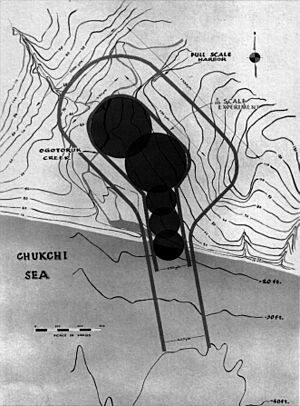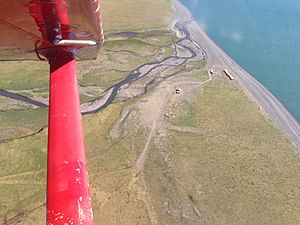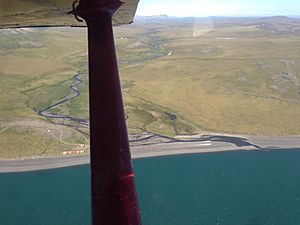Project Chariot facts for kids
Project Chariot was a plan from 1958 by the US Atomic Energy Commission. They wanted to build a new harbor at Cape Thompson in Alaska. The idea was to bury and explode several nuclear bombs to dig out the harbor.
Contents
What Was Project Chariot?
Project Chariot was part of a bigger research effort called Operation Plowshare. This project aimed to find peaceful ways to use nuclear explosives. Instead of using bombs for war, scientists hoped to use them for things like digging canals or creating harbors.
Why Was This Project Planned?
A famous scientist named Edward Teller strongly supported Project Chariot. He traveled around Alaska, telling people that the new harbor would help the state's economy. Alaska had just become a U.S. state a few weeks before. Many Alaskan leaders, newspapers, and even church groups thought it was a great idea. They believed a huge nuclear blast would be an exciting start for their new state.
Who Opposed the Project?
Not everyone agreed with the plan. The Inupiaq Native village of Point Hope was against it. Some scientists who were studying the environment also had concerns. A few groups focused on protecting nature, like The Wilderness Society and the Sierra Club, also spoke out.
In 1962, more and more people worried about the environment and the safety of the Native Alaskan people. The Atomic Energy Commission then announced that Project Chariot would be "held in abeyance." This meant it was put on hold, and it has never been officially canceled.
Why Was the Project Stopped?
One big reason the project stopped was that no one could find a real need for such a harbor. Also, studies showed that radioactive contamination from the blast could harm the local people. Their way of life depended on hunting animals.
Scientists found that radiation from global fallout was moving quickly through the food chain in the Arctic. It went from lichen (a type of plant) to caribou (which ate the lichen). Since caribou was a main food source for the local people, the radiation could reach them too. This was a major concern for their health and safety.
What Happened at the Site Later?
Even though the big nuclear explosion never happened, the Project Chariot site did get some radioactive material. In 1962, scientists brought radioactive soil from a nuclear test in Nevada to the Chariot site. They used it for experiments to see how radiation would affect the tundra. After the experiments, they buried the material.
About 30 years later, a researcher found old documents about this burial. State officials quickly went to the site. They found low levels of radioactivity about two feet deep in the buried mound. The people of Point Hope were very upset, especially because they had seen many cancer deaths. They demanded that the government remove the contaminated soil, which the government did.




